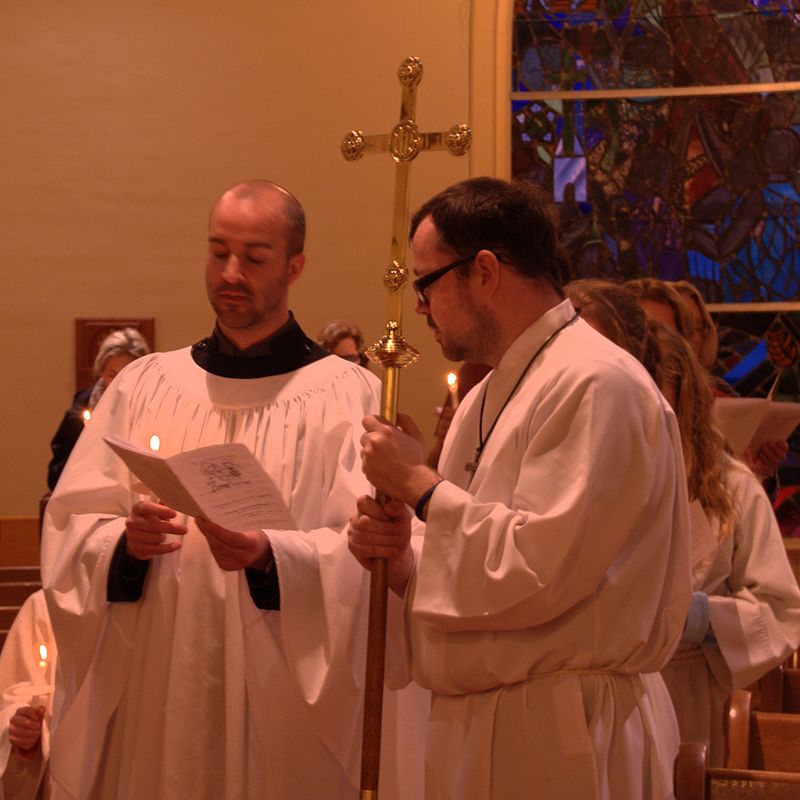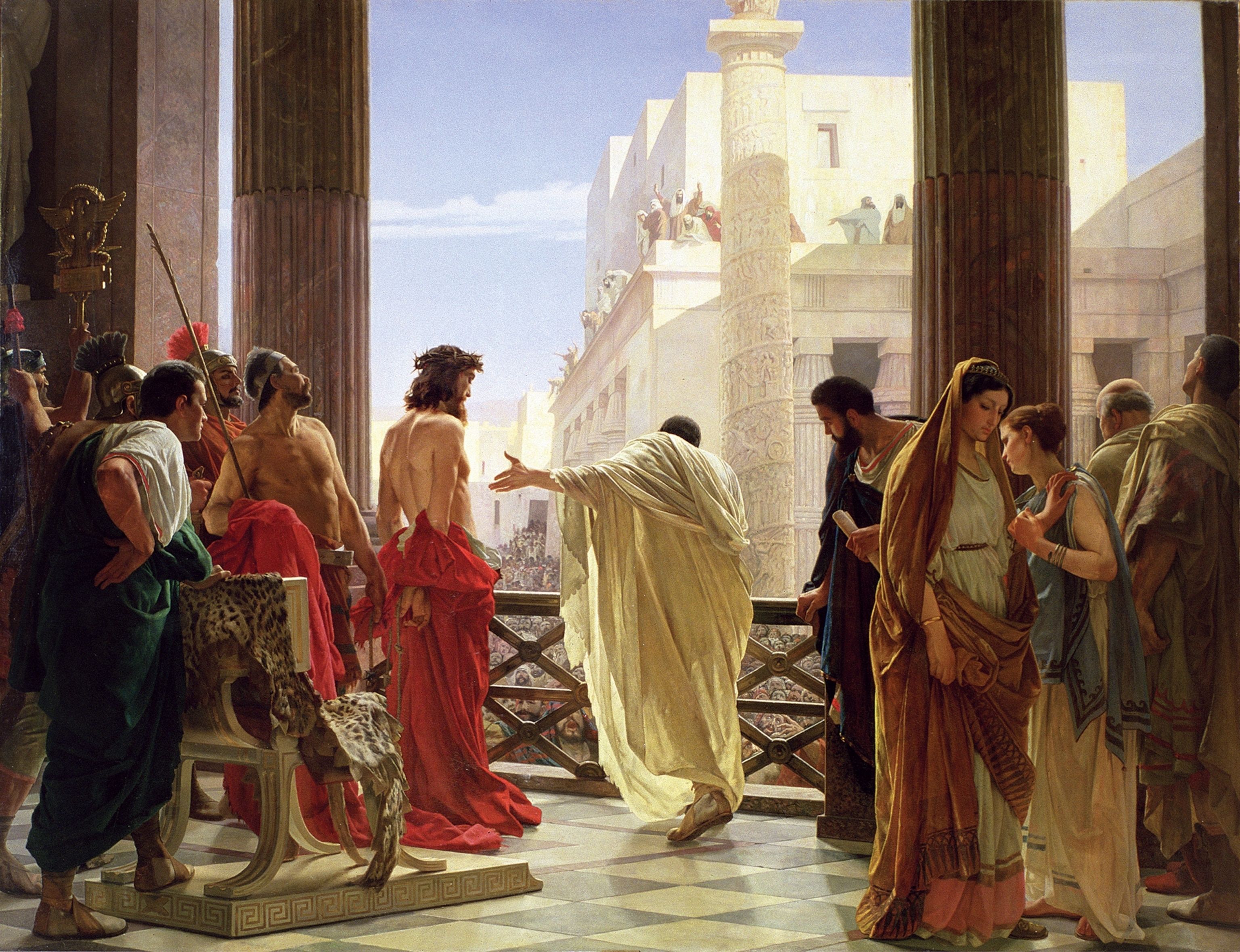
I don’t mean the Dynamic Tension of Charles Atlas. (It’s about Deuteronomy 19 and Ezekiel 3…)
* * * *
 We’re now well into Lent, 2019. (As illustrated at right.)
We’re now well into Lent, 2019. (As illustrated at right.)
That is, the time in between the holidays of Mardi Gras and Easter. In other words, it’s a time for “prayer, doing penance, repentance of sins, almsgiving, and self-denial.” And for many people, Lent means giving up something. “On the other hand, some people choose to add a discipline ‘that would add to my spiritual life.’ (See Lenten disciplines: spiritual exercises or ego trip?)”
For example, last year for Lent I gave up yelling “Hang the sonofabitch!” at every mention of Donald Trump. This year I’ll be doing the same thing. (For reasons including that my “discipline” ended up netting the United Thank Offering a little over $25 in penalties. At 25 cents a violation.) But this year I feel the need to add something else.
So – for this Lent – I’m going to try mightily to prepare a reasoned, careful, logical blog-post treatise on precisely “why I don’t like Donald Trump.” (Without resorting to the “fallacy of ad hominem attacks.”) In other words, I will try – without resorting to name-calling – to present the valid reasons why I think Trump’s presidency is a constitutional crisis on par with Watergate. (Though not yet on par with the Civil War. Not yet!)
Beyond that – for my Lenten discipline this year – I am also going to try mightily to understand why some Americans still support him. (Without saying, “What are you, dumbasses?”) And that is definitely going to be the hard part…
(A note: I firmly believe this “story” will have a happy ending, but that’s for a later blog-post.)
 So anyway, that latter part of this year’s Lenten discipline will be so hard in fact – it will take up so much time – that I haven’t a prayer of doing a new post on it within a reasonable time after my last post. (OMG! Is it time for Lent again? From March 5, 2019.) So for now I offer up this in-betweener, which as it turns out is related to unsupported name-calling.
So anyway, that latter part of this year’s Lenten discipline will be so hard in fact – it will take up so much time – that I haven’t a prayer of doing a new post on it within a reasonable time after my last post. (OMG! Is it time for Lent again? From March 5, 2019.) So for now I offer up this in-betweener, which as it turns out is related to unsupported name-calling.
In the lead caption I noted the difference between the Dynamic Tension of Charles Atlas, as distinguished from that “tension” between Deuteronomy 19 and Ezekiel, Chapter 3.
I wrote about Deuteronomy 19:16-19 – and Ezekiel 3:16-19 – in “Trump-humping” – and Christians arguing with each other. Briefly, Deuteronomy 19:16-19 says that if you accuse someone of a heinous crime – like murder or heresy – and it’s not true, you will be punished as if you had committed the crime yourself. (You can’t blithely make false accusations without penalty.) For example, if you accuse someone – perhaps even a fellow Christian – of being a “heretic,” and that accusation is false, then you will be punished as a heretic yourself.
See for example The Heresy of Liberalism | Christian Forums: “Liberalism (or to give it its proper name, heresy…) is about individual freedom… Thus where Christ offers freedom from sin, Liberalism offers freedom to sin.” But if that statement is inaccurate – and is tantamount to an accusation of heresy – the person who wrote it faces the prospect of being punished as a heretic himself. (Per Deuteronomy 19:16-19.) On that note see Santorum’s Wrong: There Is Such a Thing as a “Liberal” Christian. His name was Jesus.
 Or as I’ve noted, “If Jesus was a conservative, how come we’re not all Jewish?” See Did Jesus interpret Scripture “liberally?” That post noted that “What is called a liberal construction is ordinarily one which makes a statute apply to more things or in more situations than would be the case under strict construction.”
Or as I’ve noted, “If Jesus was a conservative, how come we’re not all Jewish?” See Did Jesus interpret Scripture “liberally?” That post noted that “What is called a liberal construction is ordinarily one which makes a statute apply to more things or in more situations than would be the case under strict construction.”
Which is pretty much what the Apostle Peter – shown at right – said in 2d Peter 3:9, “The Lord isn’t slow about keeping his promises, as some people think he is. In fact, God is patient, because he wants everyone to turn from sin and no one to be lost.” (Emphasis added, to the Contemporary English Version of the Bible.)
That is, according to 2d Peter 3:9, God seems to want the Bible to “apply to more things or in more situations than would be the case under strict construction.” Which means that the person who wrote “The Heresy of Liberalism” could be in big trouble.
On the other hand there’s Ezekiel 3:16-19, where this prophet wrote of the Christian duty to warn other Christians of the error of their ways. (I.e., characterized as “Ezekiel’s Task as Watchman.”) Briefly, if you don’t warn a fellow Christian to mend his ways, and he keeps sinning, God will punish both of you. But if you warn him – and he keeps on sinning – you will have saved your spiritual butt: “they will die for their sin; but you will have saved yourself.”
So what you end up with is a dynamic tension between Deuteronomy 19:16-19 and Ezekiel 3:16-19. Note also the twin “16-19s,” which could translate to, “It’s a message from God!”
Which means in turn that if you suspect that being “liberal Christian” is tantamount to heresy, you’re better off saying to such liberals, “Excuse me, but I think you’re reading the Bible in the wrong way.” In other words, you will want to refrain from mere, unsupported ad hominem name-calling. That’s because such phrasing could be tantamount to an accusation of heresy, punishable under Deuteronomy 19:16-19.
Because one thing you don’t want to risk is being punished as a heretic yourself…
* * * *

The 1545 “Massacre” where heretics were thrown to their death off castle walls…
* * * *
The upper image is courtesy of Dynamic Tension Charles Atlas – Image Results. See also Dynamic Tension – Wikipedia, and Charles Atlas – Wikipedia.
Re: “Trump-humping.” On a related note, see On dissin’ the Prez, and also An update on “dissin’ the Prez” – from November 13, 2016.
The “Atlantic – Evangelicals” image is courtesy of Atlantic Magazine (April, 2018) How Evangelicals Lost Their Way – And Got Hooked on Donald Trump. For another take, see Frances FitzGerald on how evangelicals lost their way, and/or How Christianity Lost Its Voice in Today’s Media Driven World.
Re: Liberalism as “heresy.” See The “Bizarro Rick Santorum” says, and “There’s no such thing as a ‘conservative Christian.”
Re: Ezekiel 3:16-19 (characterized as “Ezekiel’s Task as Watchman“). The full passage:
[T]he word of the Lord came to me: “Son of man, I have made you a watchman for the people of Israel… When I say to a wicked person, ‘You will surely die,’ and you do not warn them or speak out to dissuade them from their evil ways in order to save their life, that wicked person will die for their sin, and I will hold you accountable for their blood. But if you do warn the wicked person and they do not turn from their wickedness or from their evil ways, they will die for their sin; but you will have saved yourself.
See also Ezekiel 3 – Wikipedia: “This chapter contains the call for Ezekiel to speak to people of Israel and to act as a sentry for them.” And Night-watchman state – Wikipedia, regarding the libertarian political philosophy, which advances the “model of a state whose only functions are to provide its citizens with the military, the police and courts, thus protecting them from aggression, theft, breach of contract and fraud and enforcing property laws.”
The lower image is courtesy of Heresy – Wikipedia. The caption: “Massacre of the Waldensians of Mérindol in 1545.” The article included the following: That the first “Christian heretic to be executed, Priscillian, was condemned in 386;” That the “edict of Theodosius II (435) provided severe punishments for those who had or spread writings of Nestorius,” and that those “who possessed writings of Arius were sentenced to death;” That for some years “after the Reformation, Protestant churches were also known to execute those they considered heretics, including Catholics;” and that the “number of people executed as heretics under the authority of the various ‘ecclesiastical authorities’ is not known.” Also:
The Catholic Church by no means had a monopoly on the execution of heretics. The charge of heresy was a weapon that could fit many hands. A century and a half after heresy was made a state crime, the Vandals (a heretical Christian Germanic tribe), used the law to prosecute thousands of (orthodox) Catholics with penalties of torture, mutilation, slavery and banishment… About seven thousand people were burned at the stake by the Catholic Inquisition, which lasted for nearly seven centuries… Religious Wars slaughtered millions. During these wars, the charge of “heresy” was often leveled by one side against another as a sort of propaganda or rationalization for the unde
 “
“ It is indeed time for Ash Wednesday and Lent, again.
It is indeed time for Ash Wednesday and Lent, again. Now, about that “
Now, about that “
 That didn’t work, so in 1992 I added the discipline of daily Bible reading. (See
That didn’t work, so in 1992 I added the discipline of daily Bible reading. (See  Was Moses the first to say “it’s only weird if it doesn’t work
Was Moses the first to say “it’s only weird if it doesn’t work
 The thing is, this business of “helping your team win” has been around a long, long time. (Longer even than “
The thing is, this business of “helping your team win” has been around a long, long time. (Longer even than “
 The other night I watched
The other night I watched  My theory is that you can’t “prove” the Bible-faith by scientific or
My theory is that you can’t “prove” the Bible-faith by scientific or ![Jesus Christ, Public Defender: and Other Meditations on the Bible, For Baby-boomers, âNonesâ and Other Seekers by [Ford, James B.]](https://images-na.ssl-images-amazon.com/images/I/41fojjkSE%2BL.jpg) That’s a thought from my e-book “Jesus Christ, Public Defender.” Near the end of Chapter 8, I wrote about the early years, when I’d just started daily Bible readings and applying them to my own life. (And in particular to my own “obsession,” college football.)
That’s a thought from my e-book “Jesus Christ, Public Defender.” Near the end of Chapter 8, I wrote about the early years, when I’d just started daily Bible readings and applying them to my own life. (And in particular to my own “obsession,” college football.) But the big question remains: What are you going to do with that gift? Or in Christian terms, “How are you going to help spread
But the big question remains: What are you going to do with that gift? Or in Christian terms, “How are you going to help spread 

 Counting forward from December 25 as Day One, we find that Day Forty is February 2. A Jewish woman is in semi-seclusion for 40 days after giving birth to a son, and accordingly it is on February 2 that we celebrate the coming of Mary and Joseph with the infant Jesus to the Temple at Jerusalem…
Counting forward from December 25 as Day One, we find that Day Forty is February 2. A Jewish woman is in semi-seclusion for 40 days after giving birth to a son, and accordingly it is on February 2 that we celebrate the coming of Mary and Joseph with the infant Jesus to the Temple at Jerusalem… The
The 

 That all leads to the
That all leads to the 

 That’s one of several points noted by the New York Times’
That’s one of several points noted by the New York Times’ 

 The last post I did was on December 14, 2018. (My excuse is the rush of the holidays.) So here goes: The first post of 2019.
The last post I did was on December 14, 2018. (My excuse is the rush of the holidays.) So here goes: The first post of 2019. And while a literal view of the Three Wise Men story has them getting to the manger-scene just after Jesus was born, the truth seems a bit harder to pin down. Some say they arrived the same winter Jesus was born, while others say they came two winters after his birth. That would explain Herod’s order – noted in
And while a literal view of the Three Wise Men story has them getting to the manger-scene just after Jesus was born, the truth seems a bit harder to pin down. Some say they arrived the same winter Jesus was born, while others say they came two winters after his birth. That would explain Herod’s order – noted in 
 See also
See also 
 That
That  You can see more about this prototype in
You can see more about this prototype in  That brings us to the feast day for the “original
That brings us to the feast day for the “original 

 In one sense it talks about being
In one sense it talks about being  I figured that’d get people’s attention, but the chapter also asks questions like: Why don’t Bible Literalists interpret the “Songs of Songs” literally? Why don’t they adhere to the “exact letter or the literal sense” for this book, like all the others in the Bible?
I figured that’d get people’s attention, but the chapter also asks questions like: Why don’t Bible Literalists interpret the “Songs of Songs” literally? Why don’t they adhere to the “exact letter or the literal sense” for this book, like all the others in the Bible?![âÂÂThereâÂÂs No Such Thing as a Conservative ChristianâÂÂ: and Other Such Musings on the Faith of the Bible by [Ford, James B.]](https://images-na.ssl-images-amazon.com/images/I/41I-p6zVnFL.jpg)
 Re: Butterflies and cocoons. See also
Re: Butterflies and cocoons. See also 
 This is an
This is an  But there is an alternative. When you join the real “Army of Christ” you don’t have to spend your career going over the basics, going over the “fundamentals” again and again.
But there is an alternative. When you join the real “Army of Christ” you don’t have to spend your career going over the basics, going over the “fundamentals” again and again. I’ve used various terms to describe this type of too-literal Christian. (Not always charitably.) I’ve called them
I’ve used various terms to describe this type of too-literal Christian. (Not always charitably.) I’ve called them  On that note see
On that note see 